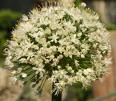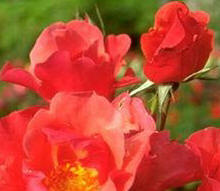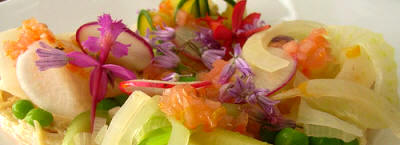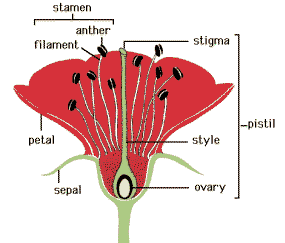 |
Alliums (leeks,
chives, garlic, garlic chives)Â All parts of these plants are
edible. The flowers tend to be stronger flavoured than the leaves.
Suitable for salads, in egg dishes such as omelettes and in soups. Â |
 |
Chive - Mild onion flavour. Suitable for salads, in egg dishes such
as omelettes and in soups. Â |
 |
Garlic -Â Milder flavour than garlic cloves. Suitable for
salads |
 |
Angelica -
Celery/liquorice flavour. Suitable for salads and fish dishes. |
 |
Anise Hyssop - Delicate liquorice flavour. |
| Â |
Arugula - See rocket |
 |
Banana Blossoms - Also know as Banana Hearts. Banana blossoms can be
cooked or eaten raw and are used in some Asian cuisines.
|
 |
Basil -Â A milder
flavour than the leaves.  Suitable for salads and
pasta dishes.
|
 |
Bergamot - Milder than the leaves - savoury/fruity flavour . Â
Suitable for salads, rice, pork and pasta dishes. |
 |
Borage and Burnet - Cucumber taste. Suitable for cold soups, sorbets
and drinks such as punch, gin & tonic, iced teas. |
 |
Calendula - Also known as
Marigolds. Flavour similar to saffron but more pungent and sometimes
bitter or peppery. Suitable for many dishes including meats,
poultry, eggs, pasta, rice and salads. Adds colour to
liquids such as milk. |
 |
Carnations/Dianthus - Sweetish spice flavour. Suitable
for desserts and salads. |
 |
Chamomile - Sweet appley Flavour. Often used to make tea. |
 |
Chervil - Anise flavour. Suitable for fish dishes. |
 |
Chrysanthemums - Slightly bitter, peppery flavour. Suitable for
salads and infusions. Blanch petals before use. |
 |
Citrus Flowers (orange,
lemon, lime, grapefruit)Â Â Use sparingly for a citrus
flavour.
|
 |
Coriander also known as Cilantro. Similar flavour to the
leaves. Suitable for salads, vegetables, pulses, grains. |
 |
Cornflower -Â Slightly sweet clove-like flavour. Suitable as a
garnish. |
| Â |
  Courgette -
see SQUASH |
 |
Day Lilies (Hemerocallis)
- Slightly sweet flavour. Suitable for desserts and for
stuffing or deep frying. NB: Do not eat other types of
lilies (Lillium)Â as they are poisonous . If in doubt - leave
it out. |
 |
Dill - Stronger flavour than the leaves. Use as the herb. Suitable
for seafood and dressings. |
 |
Elderberry - Sweet
flavour. Do not wash as this removes the flavour. Check for insects
before use. NBÂ Other parts of this plant are poisonous
except the fruit. Do not eat any part of the flower stems. |
 |
Fennel -Â Mild aniseed flavour. Use as the herb. Suitable for
desserts and garnish. |
 |
Gladiolus - Very bland flavour. Suitable for sweet and savoury
stuffings (remove the anthers) and individual petals in salads. |
 |
Hibiscus - Citrus flavour. Suitable for use in salads or as a
garnish. Use sparingly. |
 |
Honeysuckle - Sweet honey flavour. Suitable as a garnish for
desserts and salads. NB. The berries are highly poisonousÂ
so never eat them. |
 |
Jasmine -Â VeryÂ
fragrant. Suitable for tea and scenting rice dishes. |
 |
Lavender (flowers only) - Sweet flavour. Suitable as a garnish, in
savoury dishes such as stews and desserts such as custards and ices.
|
 |
Lilac -Â Highly floral, slightly bitter lemony flavour.
Suitable for salads. |
 |
Marjoram - Milder flavour than the herb.  Use as the
herb. |
 |
Mint - Minty flavour. Use as the herb particularly in marinades and
dressings. Use sparingly. |
 |
Nasturtiums - Sweet,
peppery flavour. Suitable for stuffing. Leaves are also edible lend
a peppery taste to salads or in sandwiches. Seed pods can be pickled
as used as a substitute for capers. All in all a very useful
culinary plant. |
 |
Oregano - Mild version of plant's leaf. Use like the herb. |
 |
Rocket - Also known as
Arugla. Taste similar to the leaves so can be used in the same way
especially in salads.
|
 |
Rosemary - Milder version
of the herb. Use as the herb especially good with h meats and
seafood. |
 |
Roses - The flavours depends on type and colour, but generally
fruity. All roses are edible. Suitable for garnishing desserts
and salads and excellent in syrups and jellies. |
 |
Sage - Â Flowers have
a milder flavour than the leaves. Suitable for use in salads, bean
and vegetable dishes and as a garnish for pork dishes. |
 |
Squash - Many Squash
and courgette flowers are edible . Remove
the pistols before using. Excellent stuffed and deep fried in a light batter. NB If you grow your own, try using the
male flowers first so it doesn't interfere with your vegetable
cropping. Pick before fully opened. |
 |
Sunflower - Bitter-sweet flavour. Use like chrysanthemums. Can
also be picked before the flower bud opens and steamed when they are
reminiscent of artichokes. |
 |
Thyme - Milder than the leaves. Use as you would the herb and
in salads, rice and pasta dishes. |
 |
Violets, violas, pansies - Sweet, fragrant flavour. Suitable for use
whole in salads, desserts and drinks. Excellent crystallised.Â
Leaves are also edible when steams or boiled. |









































